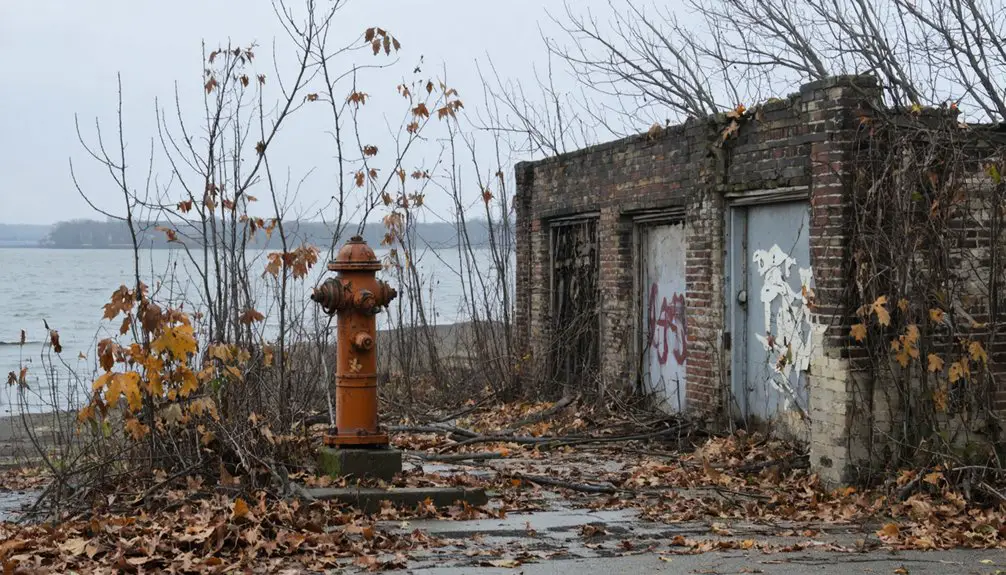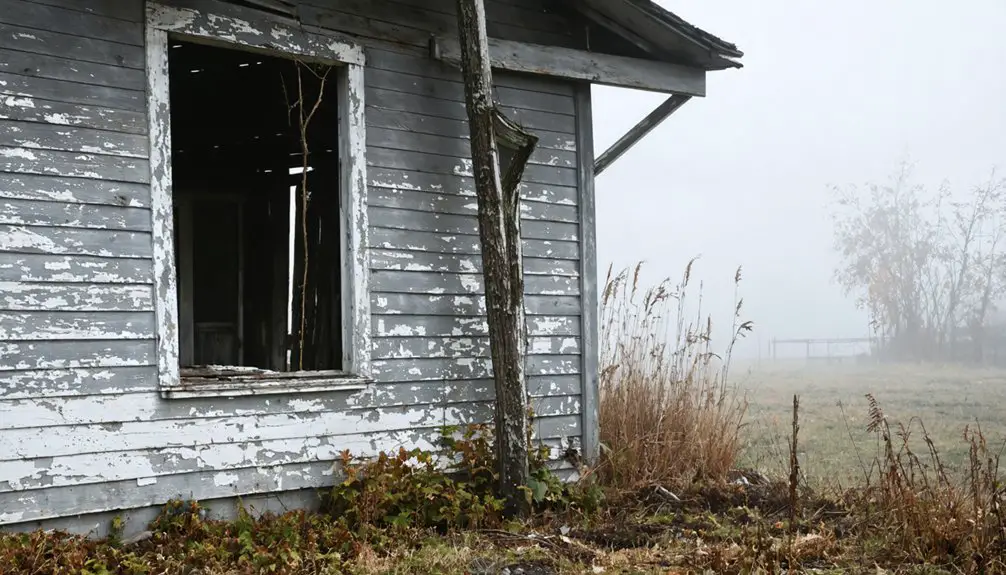You’ll find Port Sheldon’s ghost town legacy along Lake Michigan’s shore, where ambitious East Coast investors poured $40,000 into the Ottawa House hotel in 1835. The visionary settlement included a lighthouse, pier, and two miles of railroad track across 600 acres near Pigeon Creek. When the financial panic of 1837 struck, the instant metropolis crumbled, leaving ruins that nature slowly reclaimed. The story of Port Sheldon’s spectacular rise and fall holds surprising twists beyond its abandoned foundations.
Key Takeaways
- Port Sheldon became a ghost town after the financial panic of 1837 caused widespread bank failures and forced settlers to abandon the settlement.
- The ambitious 600-acre development included the luxurious Ottawa House hotel, a pier, lighthouse, and two miles of railroad track.
- Within two years of its 1835 founding, Port Sheldon’s buildings were abandoned and left to decay in harsh Michigan weather.
- The once-grand Ottawa House hotel, built for $40,000, deteriorated into ruins as nature reclaimed the abandoned structures.
- Port Sheldon’s transformation from ghost town to agricultural community began in the 1930s when berry farmers developed the land.
The Birth of an Ambitious Dream
While many 19th-century development projects aimed for modest beginnings, Port Sheldon emerged in 1835 as an audacious venture spearheaded by Pennsylvania businessman Alex Joudon and his affluent East Coast associates.
You’ll find their urban aspirations reflected in the ambitious purchase of 600 acres near Pigeon Creek for $900, where they mapped out 142 blocks with 24 lots each. Their economic vision went far beyond basic settlement – they pioneered an early version of pre-fab housing and poured resources into building a $40,000 Ottawa House hotel, complete with a lighthouse, pier, and two miles of railroad track. The developers constructed a general store and sawmill to support the growing community.
The development included plans for churches, schools, sidewalks, and even a private yacht to showcase the settlement’s prosperity. It was a bold attempt to create an instant city on Michigan’s shore. The entire project was organized under the Port Sheldon Land Company, which managed the extensive development plans.
A Vision of Urban Grandeur
Although many frontier settlements began with modest wooden structures, Port Sheldon’s founders envisioned nothing less than an instant metropolis on Lake Michigan’s shore.
You’d have seen an ambitious urban planning project unfold across 600 acres, with 142 carefully plotted blocks containing 24 lots each. Their community vision included everything you’d expect in a thriving city: sidewalks, churches, schools, and fish markets.
At the heart of this grand design stood the impressive $40,000 Ottawa House hotel, while a newly built lighthouse guided ships to the settlement’s pier. The first post office opened in 1838, serving the growing community.
The majestic Ottawa House hotel anchored Port Sheldon’s ambitious vision, its lighthouse beckoning vessels toward prosperity.
The founders even installed two miles of railroad and constructed a sawmill to jumpstart commerce. They’d pioneered an early version of prefab housing to speed up development, determined to transform Pigeon Creek’s wilderness into a bustling trade hub.
The Port Sheldon Land Company purchased this vast tract for just nine hundred dollars, launching their ambitious but ill-fated venture.
Infrastructure and Early Development
You’ll find Port Sheldon’s early infrastructure centered on the impressive $40,000 Ottawa House hotel, which stood as the settlement’s crowning achievement in 1838.
The company constructed two miles of railroad track to facilitate commerce and passenger movement, connecting the inland settlement to broader transportation networks. Similar to disambiguation pages, the railroad tracks served as a crucial navigational tool that helped guide travelers to their intended destinations.
A sturdy pier extended into Lake Michigan, complete with a lighthouse to guide vessels and support the settlement’s maritime ambitions.
Railroad and Pier Development
As regional railroad development accelerated between 1836-1841, Port Sheldon’s founders invested heavily in transportation infrastructure to support their ambitious vision of a major Lake Michigan port city.
The company secured a railroad charter to construct a line from Port Sarnia to Port Sheldon and cleared several miles of land before the project was abandoned.
The railroad expansion connected Port Sheldon to key routes like the Erie & Kalamazoo line, enabling essential shipments of coal, gasoline, grain, and timber products.
The developers constructed a magnificent depot with columns following Grecian architectural design.
Pier construction and harbor improvements became central to the company’s development strategy. You’ll find they built extensive docks and enhanced the harbor entrance to accommodate shipping vessels, while detailed surveys optimized the port’s layout.
Two daily trains provided passenger and mail service, while newly constructed roads linked Port Sheldon to Grandville and Grand Haven.
Despite these substantial investments in transportation infrastructure, the settlement ultimately couldn’t compete with Grand Haven’s superior natural harbor.
Ottawa House Hotel Construction
During Port Sheldon’s ambitious development in 1835, the Ottawa House Hotel emerged as the settlement’s crown jewel, constructed at a substantial cost of $40,000. The hotel architecture featured six impressive pillars adorning its front entrance, though four would later be salvaged and relocated to Abram W. Pike’s Grand Rapids residence. The hotel’s pillars would become a defining feature of Pike’s 1844 Greek Revival home.
You’ll find the grandeur of the Ottawa House reflected not only in its strategic location near Pigeon Creek but also in its elaborate furnishings, which the manager claimed surpassed any other establishment in the country. The hotel attracted distinguished global visitors during its brief operational period.
The financial investment in the hotel’s construction demonstrated Port Sheldon’s high aspirations, with the building serving as both a social hub and a symbol of anticipated prosperity. The structure’s quality materials proved valuable even after the town’s eventual collapse in 1847.
The Great Financial Collapse of 1837
While the United States experienced unprecedented economic growth between 1834 and 1836, the financial system’s vulnerabilities soon triggered one of America’s most devastating crashes.
The financial panic of 1837 erupted when a perfect storm of economic instability hit: land speculation bubbles burst, cotton prices plummeted, and banking failures spread nationwide. Andrew Jackson’s policies, including his refusal to renew the Second Bank’s charter, significantly contributed to the financial turmoil.
You’d have witnessed massive credit contraction as the Specie Circular drained hard currency from the system, while inflationary pressures and agricultural decline pushed food prices skyward.
Without a national bank to stabilize markets, state-chartered institutions lost nearly half their assets.
Stock values plunged – banking shares fell 32% while railroad stocks crashed 63%.
Food riots erupted in major cities, and desperate debtors fled to Texas to escape their creditors.
Abandonment and Desolation

After the 1837 banking crisis struck, you’d have witnessed the rapid abandonment of Port Sheldon as investors and settlers fled the failed development, leaving behind their economic dreams and partially-completed infrastructure.
The once-promising town’s buildings, including the grand Ottawa House hotel and commercial structures, gradually succumbed to decay and ruin throughout the following decades.
Your walk through Port Sheldon during this desolate period would have revealed only crumbling remnants of the ambitious 142-block development plan, marking Michigan’s earliest documented ghost town.
Sudden Mass Exodus
Once the Panic of 1837 triggered widespread bank failures across Michigan, Port Sheldon’s ambitious development plans crumbled into rapid abandonment.
You’d have witnessed a mass migration as settlers and investors fled the town, leaving behind their $40,000 Ottawa House hotel, general store, lighthouse, and partially built railroad.
The economic despair was swift and merciless.
With wildcat banks collapsing and credit vanishing, you couldn’t find sustainable work in the settlement’s failed commercial ventures.
The two-mile railroad proved inadequate for trade, while the incomplete harbor couldn’t compete with neighboring Grand Haven.
Without funding to maintain the town’s infrastructure or continue development, you’d have joined the exodus of residents seeking opportunities elsewhere, leaving Port Sheldon’s grand vision to decay into desolation.
Empty Buildings Decay
Bitter Michigan winters and harsh elements ravaged Port Sheldon’s abandoned structures in the years following the mass exodus.
You’ll find nature’s relentless assault left no building untouched – freeze-thaw cycles cracked foundations, while heavy rains eroded the soil beneath them. The town’s empty shells couldn’t withstand the environmental decay as water seeped through failing roofs and broken windows.
Without maintenance, the buildings’ deterioration accelerated rapidly.
Tree roots infiltrated walls, while mold and mildew weakened wooden beams. The structures you’d see became homes for wildlife instead of people – bats roosted in attics, and rodents burrowed into rotting floors.
What remains today tells a stark story: peeling paint, sagging roofs, and crumbling masonry mark the skeletal remains of Port Sheldon’s ambitious past.
Lost Economic Dreams
The grand economic vision for Port Sheldon crumbled in 1837 when the collapse of wildcat banks devastated the town’s investors. You would’ve seen the ambitious 600-acre development, with its 142 blocks and $40,000 Ottawa House hotel, suddenly grind to a halt as speculative risks caught up with the founders.
The town’s economic fragility became painfully clear as the land company’s overcapitalization left them with no sustainable revenue streams. You couldn’t find a path to recovery – the unfinished railroad, abandoned pier, and vacant lots stood as monuments to unrealized dreams.
While the area later found modest success with berry farming in the 1930s, the original vision of a bustling port city rivaling Chicago vanished into Michigan’s history, leaving behind one of the state’s earliest ghost towns.
Agricultural Renaissance
During the 1930s, Port Sheldon experienced a remarkable transformation as berry growers discovered the land’s exceptional suitability for strawberries, raspberries, and blueberries. The region’s unique microclimate along Lake Michigan created ideal conditions for agricultural innovation, breathing new life into the former ghost town.
Through strategic crop diversification, farmers capitalized on the temperate weather to establish thriving fruit operations.
You’ll find that this agricultural renaissance reshaped the entire community. Two daily trains transported produce while depots, general stores, and post offices became bustling centers of commerce.
The township exported an impressive variety of goods, including grain, pickles, bark, and logs. Today, Port Sheldon’s landscape remains dedicated to agriculture, with berry farming at its heart, preserving both its rural character and economic significance.
Economic Transformation
Founded in 1835 with grand ambitions, Port Sheldon’s initial economic trajectory took shape when Eastern investors purchased 600 acres for $900 to establish a competitive Great Lakes port city.
You’ll find that after the 1837 financial panic caused its abandonment, the community demonstrated remarkable economic resilience through transformation.
The town’s journey from ghost town to agricultural powerhouse showcases community adaptation, with these key developments:
- Discovery of ideal berry-growing conditions in the 1930s
- Establishment of critical agricultural infrastructure
- Integration of dual daily train service for commerce
- Diversification into lumber, grain, and pickle exports
- Creation of Port Sheldon Township in 1924 for local governance
Today, you’ll see Port Sheldon thriving as one of Michigan’s leading fruit producers, proving that economic success often comes through reinvention rather than initial plans.
Legacy and Historical Impact
While Port Sheldon’s initial failure marked it as one of Michigan’s earliest ghost towns, its legacy extends far beyond its short-lived dream of becoming a bustling port city.
You’ll find that this settlement’s story exemplifies the economic volatility of America’s frontier expansion, where ambitious town planning met the harsh realities of 1830s financial instability.
The town’s cultural resilience shines through its remarkable transformation. After decades of abandonment, you can trace how berry farmers in the 1930s breathed new life into the area, converting the failed speculative venture into a thriving agricultural community.
Today, Port Sheldon stands as a symbol of rural adaptation, showing you how communities can reinvent themselves when traditional urban development plans fall short. The town’s evolution from boom to bust to agricultural success has become a compelling chapter in Michigan’s settlement history.
Modern Day Port Sheldon
The modern Port Sheldon Township stands at a critical juncture, with its population of 5,650 residents facing both challenges and opportunities in 2025.
While retaining its historical significance as a lakefront community, you’ll find a modern community adapting to change, particularly with the closure of the JH Campbell Plant.
Key developments shaping today’s Port Sheldon include:
- A thorough Master Plan update through 2025
- The 48th Avenue Water Transmission project enhancing infrastructure
- An Economic Resiliency Plan targeting industrial diversification
- Available lakefront property with strategic highway access
- A stable population with a median household income of $153,162
You’ll witness a township in evolution, balancing its cherished residential character with strategic growth initiatives, all while maintaining the independent spirit that’s defined this Lake Michigan community.
Frequently Asked Questions
What Happened to the Original Port Sheldon Lighthouse?
You’ll find zero remains of the original lighthouse today – its maritime significance faded alongside Port Sheldon’s failed boom town dreams, leading to disrepair and eventual abandonment in Michigan’s lighthouse history.
Did Any Original Buildings From 1835 Survive Until Modern Times?
You won’t find any original architecture from 1835 standing today. Historical preservation records confirm that none of the first settlement’s buildings survived past the town’s financial collapse and abandonment in 1837.
How Many People Lived in Port Sheldon During Its Peak?
You’d be shocked to learn that despite dreams of a bustling port city, historical records show only 300 brave souls called this place home at its peak before population decline stripped away its historical significance.
Were There Any Documented Paranormal Activities in Abandoned Port Sheldon?
You won’t find documented evidence of ghost sightings or eerie sounds in the area’s records. Unlike other Michigan ghost towns, there aren’t any verified paranormal claims from reliable historical sources.
What Was the Average Property Value During Port Sheldon’s Initial Development?
You won’t find exact historical pricing, but the property market suggests values were speculative, with land starting at $1.50 per acre in 1835 before infrastructure investments dramatically inflated expectations.
References
- https://99wfmk.com/one-of-michigans-first-ghost-towns/
- https://wrkr.com/lost-community-near-grand-haven-is-one-of-michigans-first-ghost-towns/
- https://www.migenweb.org/ottawa/twprecords/ptsheldon/portsheldon.html
- https://kids.kiddle.co/List_of_ghost_towns_in_Michigan
- https://www.migenweb.org/ottawa/twprecords/ptsheldon/history.html
- https://wbckfm.com/one-of-michigans-first-ghost-towns/
- https://www.portsheldontwp.org/history/
- http://genealogytrails.com/mich/ottawa/compendium_pg1.html
- https://www.fox17online.com/news/local-news/lakeshore/ottawa/fruit-farms-and-freshwater-port-sheldon-township-to-celebrate-its-centennial
- https://en.wikipedia.org/wiki/Shelldrake



